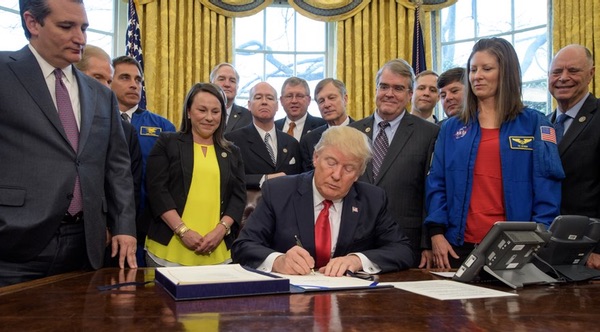Which comes first for a new National Space Council: organization or vision?by Roger Handberg
|
| Proposals for a new space council reflect a concern that NASA and, by extension, the United States, is failing to meet the challenges of the future. |
The first President Bush in 1989 tried to reignite the Apollo spirit with announcement of the Space Exploration Initiative (SEI). That initiative quickly died from lack of congressional support, as explained in a monograph by Thor Hogan. The National Space Council was fully engaged in the battle over SEI and was powerful enough to subsequently force NASA Administrator Richard Truly out of office when disputes arose over the future directions of NASA. Hogan argues that the failure of SEI was partially because the space council did not intervene sufficiently to keep budget proposals realistic. Whether that would have made a difference is difficult to discern now, but the takeaway by many was that space was too important to leave to NASA.
A National Space Council in some form would become the leader in space policy going forward because it would have a broader perspective on possible future directions. Despite this view, no succeeding president has resurrected a space council despite repeated calls for such an event, but the efforts are picking up new momentum in the new Trump Administration. This may reflect the view that President Trump lacks interest in space, although how that makes him different from earlier presidents is unclear. Alternatively, the view might be that the president can be convinced to reestablish the council because he lacks such views and those he holds are subject to revision.
Proposals for a new space council reflect a concern that NASA and, by extension, the United States, is failing to meet the challenges of the future. That is, there is no identifiable future in term of goals of where to go next in space or even how to keep up with the Chinese, the new rival replacing the former Soviet Union. The expectation is that a revived council would provide leadership and direction since the chair would be the Vice President of the United States (Vice President Dan Quayle chaired the Bush council.) All this assumes that the vice president is in harmony with the president and can facilitate getting presidential agreement to whatever a space council might propose. The reality is that, unless the president concurs, the vice president possesses little independent power.
The question if there is a new National Space Council
All of this sounds good but reality often proves more daunting. The question that undermines such facile expectations is this: which comes first, the vision or the organization? Bureaucracies and their derivatives are not celebrated for their vision. Quite the contrary. Vision is something more than a simple linear extension of the past but, rather, a goal or set of goals that transcend the present, often mundane, reality. Organizations are necessary realities to execute the vision but in themselves are not usually considered visionary. A revived space council may smooth the path forward but the more likely outcome is that, in the absence of an articulated vision, it will just add another layer of bureaucracy.
| A space council in itself cannot generate the enthusiasm and excitement sufficient to move the US space program toward a new vision. The vision must come first but that is hard because doing space is hard and expensive. |
If the Trump Administration has or can develop a bold vision for moving forward, then the National Space Council may become the venue within which that vision gets implemented. The first President Bush’s willingness to support the SEI was positive but the NASA proposal for implementation failed because its budget numbers were unrealistic: $400 billion. A space council might ameliorate some of that, but the reality was that SEI was not itself considered visionary but rather a plan based on satisfying all the vested interests within NASA. Failure followed almost automatically.
A space council in itself cannot generate the enthusiasm and excitement sufficient to move the US space program toward a new vision. The vision must come first but that is hard because doing space is hard and expensive. The vision may arise out of a crisis similar to Apollo, the crisis then being political. The crisis can be political or existential, such as an approaching near Earth object on a collision course; an extinction-level event, possibly. Such an event may galvanize support for a long-term space vision but, in the case of the NEO, the vision may come too late. The more we know, the more dangerous space becomes even to those on Earth, never mind out there.
Chicken or egg, space council or vision; whichever comes first will be the ultimate test.
